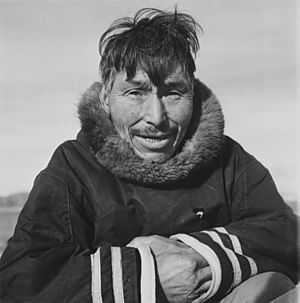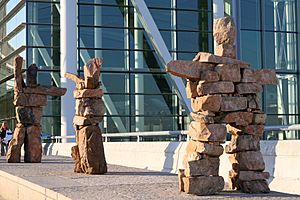Kiakshuk facts for kids
Quick facts for kids
Kiakshuk
|
|
|---|---|

Kiakshuk photographed by Rosemary Gilliat in 1960 in Cape Dorset, Nunavut
|
|
| Born | 1886 |
| Died | May 3, 1966 (aged 79–80) |
Kiakshuk (born 1886, died 1966) was a famous Inuit artist from Canada. He was skilled in both sculpture (making art from materials like stone) and printmaking (creating pictures by pressing ink onto paper). Kiakshuk started making prints when he was over 70 years old! He is best known for his "real Eskimo pictures." These artworks show traditional Inuit life and old stories.
Kiakshuk's Life Story
Kiakshuk was born in 1886 on the northern part of Baffin Island in Nunavut. Around 1900, he moved with his family to Cape Dorset, which is in the south of Baffin Island. Before he became an artist, Kiakshuk was a hunter. This was how he supported himself and his family.
In 1958, Kiakshuk was in a movie called The Living Stone. This film was made by the National Film Board of Canada. In the movie, Kiakshuk shares old Inuit folk tales. He also sings traditional songs and talks about how important sculpture is to a group of children.
Many people in Kiakshuk's family also became artists. His son, Lukta Qiatsuq, and his daughters, Ishuhungitok Pootoogook and Paunichea, were artists. His cousin, Pitseolak Ashoona, was also a well-known artist.
Kiakshuk's Art Career
Kiakshuk learned how to make prints from James Archibald Houston. Houston was an artist hired by the Canadian government. His job was to help develop Inuit art and crafts in the far North. Houston started working in the Cape Dorset area, where Kiakshuk lived, in 1956.
Houston helped set up an art co-operative in Cape Dorset. This group helped encourage Inuit art. In 1958, Houston traveled to Japan. He studied printmaking with artists from the Sōsaku-hanga movement. When he came back, he taught these printmaking techniques to the co-operative.
Wood is very rare in Cape Dorset. So, the Japanese printmaking methods had to be changed. Kiakshuk and other artists learned to use stone instead of wood. This led to a special kind of art called stonecut printmaking. Unlike Japanese woodcut prints, Inuit artists often carve just one stone block. They then apply all the colors to that same block for printing.
Kiakshuk's art often showed stories from Inuit religion. He also drew scenes from everyday life.

In 1963, Kiakshuk created three large stone sculptures called inukshuks. These were made for Toronto Pearson International Airport in Toronto. The sculptures were put back in place in 2002. There has been some discussion about them. Some Inuit people believe the sculptures were placed in a way that was not respectful.
Kiakshuk also sold his drawings and prints for books. One example is Eskimo Songs and Stories, published in 1974. In 1979, one of Kiakshuk’s prints was even featured on a Canadian postage stamp. The American rock band DIIV used Kiakshuk's artwork on the cover of their 2012 album, Oshin.
Art Exhibitions
Kiakshuk's art has been shown in many exhibitions. These shows help people see and learn about his amazing work.
- Ten Years of Eskimo Prints and Recent Sculptures - National Gallery of Canada, 1967
- Strange Scenes—Early Cape Dorset Drawings - McMichael Canadian Art Collection, 1993
- Classic Prints from Cape Dorset: 1960-1972 - Alberts Gallery of Inuit Art, 2003
- Then and Now: Inuit Prints from 1962-2002 - Inuit Gallery of Vancouver, 2003
- Kiakshuk: Images by a Hunter-Artist - National Gallery of Canada, 2001-2002
Art Collections
Many museums and art centers around the world own Kiakshuk's artwork. This means his art is preserved and can be seen by many people.
- Agnes Etherington Art Centre
- British Museum
- Fine Arts Museum of San Francisco
- McMaster Museum of Art, McMaster University
- Metropolitan Museum of Art
- Museum of Anthropology, University of British Columbia
- Museum London
- National Gallery of Canada
- National Museum of the American Indian
- Pennsylvania Academy of the Fine Arts
- San Juan Islands Museum of Art
- University of Michigan Museum of Art
- Whyte Museum of the Canadian Rockies

